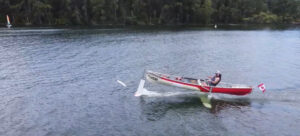From the imagination of Camosun Mechanical Engineering Technology student Dermot MacDougall comes the Millenium Phoenix—the world’s first flying canoe. Built as a capstone project with four other Camosun students, MacDougall proved to himself with the canoe that he can bring an outrageous idea to fruition.
“I was thinking one day, I was at school, how cool would it be to make, like, a hydrofoil boat? How cool would it be to make something that you could just bring out to the lake, you could hop on and fly around on?” says MacDougall. “And keep this in mind—I was listening to a lot of Top Gun music at the time, so I was thinking about that. And I was thinking, well, it’d be kind of hard to make a boat itself. The hydrofoil stuff I kind of think I could do, but making a boat, maybe that’s a bit beyond me right now.”
However, MacDougall had an 18-and-a-half-foot-long canoe that he could put hydrofoils on and accomplish the gist of his idea. He pitched it as his capstone project and after a few returns to tweak the design, it was accepted by his instructors.

“That maiden flight was in August, and I had started this back in December,” he says. “So, it’d been eight months leading up to this.”
With only one successful lift-off from the water completed the day before the showcase, the flying canoe set out to be graded.
“Basically, on that maiden voyage, when we did first hit the flight, I was really nervous beforehand because this had turned into me having some silly idea driving home from school to now I had four other students working with me; I had my professors out there; I had friends out there. Everybody coming to watch to see this thing at work. It turned into quite the ordeal, and it was this huge capstone project. So, I was pretty nervous about that.”
Out at Elk Lake with one instructor in the flying canoe, one in the safety boat with two teammates, and another instructor watching through a drone feed, the maiden voyage took flight.
“We finally get lined up and I pull the trigger, which is our throttle because we use an electric [motor], and I start going in the boat,” says MacDougall. “So, I press the trigger and it’s got quite a lot of power. There’s waves splashing everywhere, the boat’s rocking around. You can hear all the metal pieces shaking, shaking, shaking, you’re jolted back in your seat, you’re moving, shaking, shaking, then—boom—silence and I could hear nothing else at this time. Just boom, silence, smooth. And I hear my professor say ‘dry hull,’ which, I just remember… I don’t even know how to say how excited I was then because that just meant the boat had lifted out of the water. So that was great. That was the coolest feeling ever.”
Getting about a foot to a foot and a half out of the water, the flying canoe successfully took flight. MacDougall says as he “came back to reality” he could hear his teammates screaming and cheering from the shore. He says he did around 10 test flights, each of which was roughly one to two minutes long. However, the true test of success for MacDougall came later.
“I knew my project was successful when people started asking me what’s next,” he says. “And that was the most satisfying part of this project once I was done. People weren’t being like, ‘Oh, that was crazy.’ They’re asking, ‘So what’s the next project? What’s the next crazy thing?’ That was… As a student, that is the best feeling.”
